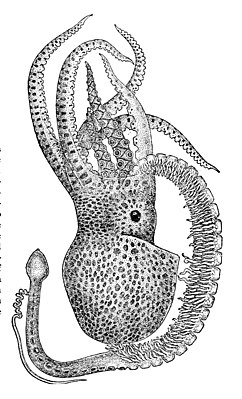Holey octopus
| Holey octopus | ||||||||||||
|---|---|---|---|---|---|---|---|---|---|---|---|---|

Side view of the adult male with a hectocotylus |
||||||||||||
| Systematics | ||||||||||||
|
||||||||||||
| Scientific name | ||||||||||||
| Tremoctopus violaceus | ||||||||||||
| Chiaje , 1830 |
The holey octopus ( Tremoctopus violaceus ) is a geographically relatively widespread but rather rare cephalopod (Cephalopoda) from the large group of octopuses that lives in the upper open water zone ( epipelagial ) of the open sea .
anatomy
The female animal becomes up to 2 m long and 10 kg heavy. The male, however, is only 3 cm long and weighs ¼ g (a so-called dwarf male ). It is just the size of the female's pupil . The female can be 40,000 times heavier than her partner, which is the record among larger animals . One such extraordinary sexual dimorphism known in the animal kingdom otherwise only by some barnacles and the hedgehog worm Bonellia viridis .
pairing
One of the male's eight arms is hollow and fills with sperm when the animal finds a female. Then this arm, also called the hectocotylus , is repelled and migrates independently into the female's mantle cavity . It stays there until the female has fertilized the eggs with the sperm from her arm . After mating, the male dies.
Others
Males and young females use torn, poisonous tentacles from the Portuguese galley for defense; they themselves are immune to the poison. The tentacles are held with the suction cups on the upper two arms .
In July 2019 the Croatian islands of Hvar , Brač and Šolta saw an increased incidence of the holey octopus, which is very rare in the Adriatic. An increased occurrence of the blanket octopus in Dalmatia was last reported in 1936.
Web links
Individual evidence
- ↑ First encounter with a live male blanket octopus: the world's most sexually size-dimorphic large animal
- ↑ Lauren Simmonds: Rarely Seen Octopus Appears in Adriatic Near Hvar, Brač and Šolta. July 21, 2019, accessed on August 14, 2019 .


